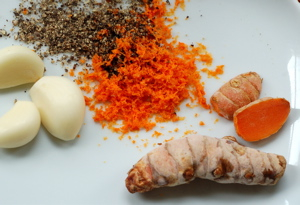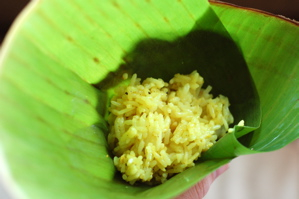
Learning the true shape of our food sometimes comes as a surprise. The challenge of carrying ingredients across time and distance plus the reality of everyday cooking has transformed the look, feel and – most importantly – taste of many foods.
That dry, yellow powder known here as turmeric is certainly one of them.
Looking at a little bottle of it in the supermarket, it’s hard to believe that this cousin of ginger boasts the same family’s gracefully arched leaves and large, stunning blossoms. There are many varieties grown in India, from where nearly all the world’s supply comes. Turmeric’s fragrant bite and intensely golden hue make it a key ingredient in the cuisine and culture of Asia’s southern and southeastern regions. It’s applied as an effective antibacterial tonic in Ayurvedic medicine, simmered in peppery Burmese soups and infused into golden cones of nasi kuning at Indonesian weddings.
Many foods more familiar to Westerners, say ballpark mustard and certain cheeses, also gain their yellow hue from turmeric. It’s often dismissed, unfairly, as a lesser substitute for saffron by those who haven’t tried it in its whole, fresh form or who aren’t familiar with its native, rather than derivative, uses. The Royal Botanical Kew Gardens maintains an excellent website where you can learn more about the ancient history, botany, medicinal uses and spiritual traditions of turmeric.
Selecting and Storing
Look for the slim, orange rhizomes of fresh turmeric in the produce section of Asian and Indian markets, in small bags near where the herbs are sold. Buy rhizomes with bright, smooth peels, avoiding any with soft spots, dark bruises or dried out tips. They freeze well and grate easily while still frozen. Just immerse what you need in some warm water for a few minutes, than proceed to peel and grate.
For each teaspoon of dry turmeric in a recipe, substitute about 1 inch of fresh turmeric. Peel the thin outer layer by gently scraping with the edge of a spoon’s bowl, and then grate the rhizome finely with a microplane or a ginger grater. It’s best to bring out the color and flavor of the fresh rhizome with a quick stir in some hot oil.

Some simple ways to enjoy turmeric:
- Use it in any curry recipe that calls for dry, ground turmeric, adding it to the pan after the dry spices have been toasted or stirring with other aromatics that are cooked in oil.
- To dress up leftover rice: Saute grated turmeric, minced garlic, salt and a generous amount of black pepper in hot oil until fragrant and golden. Stir in a few tablespoons of coconut milk. Add cooked rice and stir until evenly coated. Serve hot. For a special meal, transfer the rice to banana leaves and steam for 20 minutes.
- To make a lovely Burmese soup: Stir several crushed garlic cloves, a small amount of paprika and half a teaspoon of grated turmeric into a couple cups of chicken broth. Simmer for 10 to 20 minutes, then add thinly sliced seasonal vegetables such as daikon, chayote, spinach, mustard greens, watercress or even carrots. Season to taste with salt and a generous grinding of black pepper, then sprinkle with chopped cilantro or scallions just before serving.
- For a refreshing cucumber sauce over fried or grilled fish: Halve lengthwise 2 or 3 small, pickling cucumbers or 1/2 of a hothouse cucumber. Scoop out seeds and cut into thick slices. Stir grated turmeric and onions in hot oil until fragrant and bright golden. Add chopped garlic and finely shredded ginger, then stir in the cucumbers, 1/2 cup of stock and, optionally, a spoonful of coconut milk. Simmer just until the cucumbers are warmed through, then transfer to serving bowl or pour over cooked fish.
- The next time you’re at an Indian market, look for turmeric pickles tucked in among the other mango, lime and eggplant pickles. One of my favorites!
- To brighten your own favorite salsa, chutney or pickles: Grate turmeric, then heat it in the oil or a small amount of the liquid used in the recipe or even a bit of the pickling brine from purchased pickles. Stir well with other ingredients.
- Experiment with this natural food coloring by slipping a bit into any recipe that calls for ginger. You never know, that bright, new dish might become a classic from your kitchen.